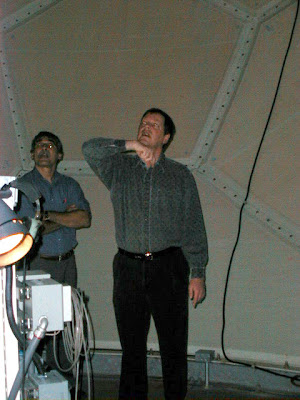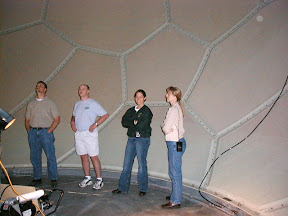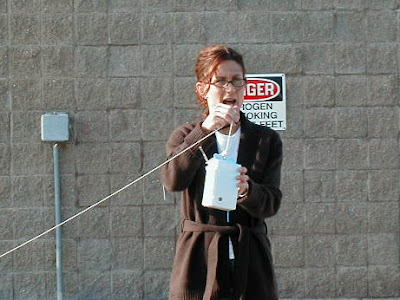I discovered some forgotten photographs from a few years ago of the National Weather Service office in Davenport, IA. The American Meteorological Society offered a course for science teachers which involved several visits to the NWS office and presentations and tours about weather forecasting. A favorite part of the course was the tour of this doppler radar dome. The fiberglass dome is about 30′ across. It protects the 28′ radar dish. The tower is about 80′ tall. More detailed information about doppler radar is available at this link.

We gathered at the base of the tower near the stairs. Most of us were eager to climb up. A few people were very troubled by the open stairs and fear of height. But, we all did make it to the top.

Before entering the hatch to the dome, I got this picture of the NWS office and horizon.

The weather was clear and calm in all directions. The radar had been shut down so we could enter. There is no room for a person inside if the dish is rotating. Here, our tour leader is explaining some of the features to us.




Quoting from the NWS web page…
As the radar antenna turns, it emits extremely short bursts of radio waves, called pulses. Each pulse lasts about 0.00000157 seconds, with a 0.00099843-second “listening period” in between. The transmitted radio waves move through the atmosphere at about the speed of light.
This information is observed within the approximately 0.001-second listening period with the process repeated up to 1,300 times per second. By keeping track of the time it takes the radio waves to leave the antenna, hit the target, and return to the antenna, the radar can calculate the distance to the target.
The WSR-88D’s pulses have an average transmitted power of about 450,000 watts. By comparison, a typical home microwave oven will generate about 1000 watts of energy. However, because of the very short period the radar is actually transmitting, when the time of all pulses each hour are totaled (the time the radar is actually transmitting), the radar is “on” for a little over 7 seconds each hour.
The hardest part of the tour was coming down the open stairs. It was awkward and almost easier to turn around and go backwards. Most people gamely gripped the rails and white-knuckled it down.


I noticed this unusual building in the distance. It is the building used for launching weather balloons. About 800 places around the world do balloon releases twice daily, usually at 0000 universal time and 1200 UTC. Some places do special releases when meteorologists determine there is significant weather that needs to be monitored. The balloons carry instruments aloft to send back information on atmospheric pressure, temperature, humidity and wind speed by means of a small, expendable measuring device called a radiosonde. To obtain wind data, they can be tracked by radar.



Radiosonde

The balloon will burst at high altitude and drop the radiosonde by parachute.

Good post,
Visit my tech webpage.
http://www.itremotesolutions.com
Thanks
Thank so much. I will visit your page asap.
Very interesting as I always wondered about the inside!
It was a great opportunity I was glad to have. I’m glad you enjoyed it, too.
Thanks for stopping and for your comment.
I agree with Frank, very interesting…and also very cool!
I also found this post interesting. It’s fun to see what it’s like in the doppler radar dome and at the balloon launch site.
I’m glad you liked it. It was fun to be part of it.
Cool, I also wrote on this topic but it was more of a scientific overview. You will surely love it.
check it out here: http://www.insidetheradar.com/inside-the-radar
Thanks for the link. It is good to teach about these things common in our lives.
Come visit again.